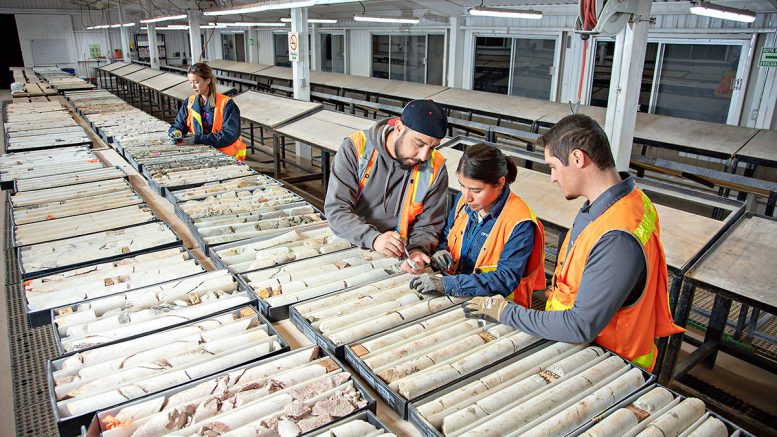Alamos Gold (TSX: AGI; NYSE: AGI) has extended the high-grade mineralization at the Puerto Del Aire (PDA) satellite deposit beyond existing reserves and resources of the Mulatos mine in Sonora state, Mexico.
The company encountered the mineralization within a 200-metre gap between the PDA1 and PDA2 zones, highlighting the potential for further resource expansion. Many intercepts were well above the current reserve grade.
The PDA deposit has current proven and probable reserves of 2.9 million tonnes grading 4.7 grams gold per tonne for 428,000 oz. of metal, out of the Mulatos total of 29.4 million tonnes grading 1.6 grams gold per tonne for 1.5 million oz. gold.
The higher-grade underground deposit comprises five zones next to the central Mulatos pit.
Today’s drill results showed excellent grades and true widths, with 70% of the holes intersecting grades above the 3 grams gold per tonne underground cut-off grade.
Highlight holes included 20.8 grams gold per tonne over 5.3 metres and 9.3 grams gold over 10.4 metres, showing the potential for higher-grade zones within the broader mineralized envelope.
“These exploration results highlight the significant potential to add higher-grade reserves and resources at PDA,” said Alamos CEO John McCluskey in a statement. “They are also a further demonstration of the potential within the Mulatos District and our long-term track record of exploration success.
“We expect Puerto Del Aire will extend that life further with excellent potential to be another low-cost, high-return project as with La Yaqui Grande and the past producing Cerro Pelon and La Yaqui Phase I operations,” said McCluskey.

The Puerto Del Aire satellite deposits at Mulatos, Mexico. Credit: Alamos Gold.
Alamos plans to access the five current reserve blocks, including PDA1, PDA2, Gap, Victor and Estrella, by ramps and development drifts off the main Mulatos pit. This higher-grade ore would be processed through the existing 500-tonne-per-day mill at Mulatos, which analysts at Haywood Capital Markets expect would be upgraded to get to about 1,000 tonnes per day milled. According to mining analyst Kerry Smith, that would likely result in a 40,000 to 60,000 oz.-per-year operation.
With the current grades and easy logistics located next to the existing Mulatos pit, capital costs would be modest, primarily for underground development and a mill upgrade. PDA should have cash costs in the US$800 to $900 per oz. range. These reserves would likely be mined by an underground mine contractor, similar to what Alamos did at the now mined-out San Carlos zone, located just east of the Mulatos pit, Smith wrote in a note to clients.
Alamos has previously permitted several satellite deposits at Mulatos. For this reason, Smith expects permitting these reserves, given they are within the current Mulatos open pit area, to be simple, assuming a new mining permit is even required.
Reserve replacement history
The operation has a six-year mine life based on current reserves, similar to the start of production in 2005, demonstrating a strong track record of exploration success.
In addition to the Mulatos heap leach operations, Alamos constructed a mill to process ore from the Escondida high-grade zone until it was depleted in 2014, followed by the San Carlos high-grade underground deposit which was depleted in 2018.
The higher-grade La Yaqui Phase I satellite project was built in 2017 and produced about 60,000 oz. and generated US$40 million of free cash flow (net of US$13 million of construction capital) before being depleted in 2019.
Construction of the higher grade, high-return Cerro Pelon project was completed in 2019, with initial production achieved ahead of schedule. This project has produced about 127,000 oz. and generated over US$107 million of free cash flow (net of US$25 million of initial capital) as of December 2021.
Most recently, the construction of La Yaqui Grande was completed in June, with initial production achieved that same month.
Based on the completed 57 holes for 17,788 metres of drilling to date, Alamos plans to deliver a development plan in the third quarter of next year.
“We expect it would take two years to complete underground development and modify the mill, with the first production by late 2025 at the earliest,” said Haywood’s Smith. “Exploration and step-out drilling will continue, as the Mulatos property is large and underexplored.”
Four rigs continue to drill at PDA with a focus on step-out drilling. The objective is to extend these higher-grade zones, given the success of growing the reserve and resources here.
Alamos has a high-quality production base, and 70% of its production is from Canada. That could grow to about 800,000 oz. by 2027 through its Lynn Lake project development in Manitoba.
At $11.91 per share, Alamos stock is up about 10% over the past 12 months, ranging between $8.30 and $12.06. The company has a market cap of $4.7 billion.


Be the first to comment on "Alamos extends high-grade gold zone at Mulatos satellite"